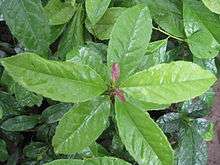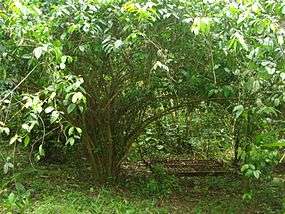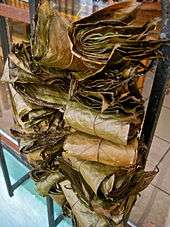Ilex guayusa
Ilex guayusa (/ˈaɪlɛks ˈɡwaɪjuːsə/ or /ˈaɪlɛks ˈwaɪjuːsə/) is a species of tree of the holly genus, native to the Amazon Rainforest. One of three known caffeinated holly trees, the leaves of the guayusa tree are dried and brewed like a tea for their stimulative effects.[1]
| Ilex guayusa | |
|---|---|
 | |
| Scientific classification | |
| Kingdom: | Plantae |
| Clade: | Tracheophytes |
| Clade: | Angiosperms |
| Clade: | Eudicots |
| Clade: | Asterids |
| Order: | Aquifoliales |
| Family: | Aquifoliaceae |
| Genus: | Ilex |
| Species: | I. guayusa |
| Binomial name | |
| Ilex guayusa | |
Description
Ilex guayusa is an evergreen dioecious[2] tree which grows 6–30 m (20–98 ft) tall.[3] The leaves are ovate, elliptic, oblong or lanceolate; 7–22 cm (2.8–8.7 in) long, 2.5–7 cm (0.98–2.76 in) wide; with serrate or dentate margin.[3] The flowers are small and white, arranged in thyrses.[3] The fruit is spherical and red, 6–7 mm (0.24–0.28 in) in diameter.[3]
Distribution and habitat
I. guayusa is native to the upper Amazonian regions of Ecuador, Peru, and southern Colombia, between 200–2,000 m (660–6,560 ft) of elevation.[3] However, it has also been collected in Bolivia in 1939.[4] It is present in evergreen or deciduous premontane forests, especially ones dominated by Dictyocaryum palms.[3] Guayusa has been collected only rarely in the wild by botanists and is known almost exclusively as a cultivated plant (especially in the Ecuadorian provinces of Napo and Pastaza).[5]
Ecology

This species is found wild and cultivated in sandy-loamy soils of pH 4.34–5.01 with low cation-exchange capacity and high metal content.[6] The vegetation type preferred is lowland and premontane, neotropical jungle where conditions of soil, precipitation and humidity are appropriate for its development.[6] Despite being a monoecious species and prone to floral polygamy, Ilex guayusa appears to yield little fertile material, so it relies mostly on asexual reproduction (basal shoots, sprouts and suckers).[6] In its initial growth stages, Ilex guayusa behaves as an understory species, becoming a shrub with spreading branches when it receives higher amounts of light, eventually becoming a tree.[6]
History
The earliest evidence of human utilization of this species is a 1,500-year-old bundle of guayusa leaves found in a medicine man's tomb in the Bolivian Andes, far beyond the natural range of the plant.[4]
Father Juan Lorenzo Lucero reported in 1683 the daily consumption of guayusa in infusions by the Jivaroan peoples.[7]
In the 18th century, several missionaries in Colombia, Ecuador and Peru wrote about the uses of the plant, and some of them also consumed the infusion citing digestive and stimulant properties.[7]
The Jesuits knew about the medicinal uses of the plant and traded it actively.[8]
A grove found in 1857 by Richard Spruce near the town of Baños, Ecuador was supposedly cultivated since precolumbian times.[5]
Vernacular names

Uses
Leaves of Ilex guayusa are used to make an infusion, especially in Ecuador, Peru and Colombia.[3][5][8][9] After harvest, leaves are dried, which allows flavor to develop.[5]
Jivaroan peoples in Ecuador and Peru, also prepare a drink from the leaves to be drunk in large amounts during pre-dawn ceremonies that involve the vomiting of the excess drink to wash out the stomach and small intestine and avoid absorbing too much caffeine.[3][5] A ritual use by the Kichua people involves drinking guayusa infusion to have foretelling dreams for successful hunting expeditions.[10]
Guayusa is also consumed in parties and local festivals as a social drink, especially by the Kichua people in Ecuador.[8]
In the three aforementioned countries, guayusa is used in the preparation of artisanal alcoholic drinks.[8]
Chemical composition

Guayusa leaves contain caffeine (1.73–3.48 %), theobromine and other dimethylxanthines (among them paraxanthine and theophylline).[5] Guayusa leaves also contain L-theanine, gallic acid, guanidine, isobutyric acid, nicotinic acid, ascorbic acid, riboflavin, choline, pyridoxine, triterpenes, chlorogenic acid and sugars among other compounds.[6]
See also
- Yerba mate (Ilex paraguariensis) - South American caffeinated holly species used to make Mate.
- Yaupon holly (Ilex vomitoria) - southeastern North American caffeinated holly species used to make the Black Drink.
- Kuding (Ilex kudingcha) - Asian holly species used with Ligustrum robustum for Chinese kǔdīng chá tea.
References
- "Ecuador's "Superleaf" Tea: Could It Replace Your Afternoon Coffee?". 2014-07-04.
- Shemluck, Melvin (1979). "The flowers of Ilex guayusa" (PDF). Botanical Museum Leaflets. Harvard University Herbaria. 27 (5/6): 155–160. Archived from the original (PDF) on 2016-10-06. Retrieved 2016-03-12.
- Loizeau P.-A.; G. Barriera (2007). "Aquifoliaceae of Neotropics Ilex guayusa Loes". Monographia Aquifoliacearum. Retrieved 2 August 2011.
- Schultes, R. E. (1972). "Ilex guayusa from 500 AD to the present". In Wassén, H.; et al. (eds.). A Medicine-Man's Implements and Plants in a Tiahuanacoid Tomb in Highland Bolivia. Etnologiska Studier. 32. Goteborgs Etnografiska Museum.
- Lewis, WH; Kennelly, EJ; Bass, GN; Wedner, HJ; Elvin, L (1991). "Ritualistic use of the holly Ilex guayusa by Amazonian Jivaro Indians". Journal of Ethnopharmacology. 33 (1–2): 25–30. doi:10.1016/0378-8741(91)90156-8. PMID 1682531.
- Sequeda-Castañeda, L. G.; et al. (2016). "Ilex guayusa Loes.: Amazon and Andean native plant". PharmacologyOnline. 3: 193–202. ISSN 1827-8620.
- Patino, Victor Manuel (1968). "Guayusa, a neglected stimulant from the eastern andean foothills". Economic Botany. 22 (4): 311–316. doi:10.1007/bf02908125. ISSN 0013-0001.
- Duenas, Juan; et al. (2016). "Amazonian Guayusa (Ilex guayusa Loes.): A Historical and Ethnobotanical Overview". Economic Botany. 70 (1): 85–91. doi:10.1007/s12231-016-9334-2.
- "Guayusa - Patrimonio Alimentario". patrimonioalimentario.culturaypatrimonio.gob.ec (in Spanish). Retrieved 2017-07-14.
- Spruce, R. (1996). Notas de un botánico en el Amazonas y los Andes. Quito, Ecuador: Colección Tierra Incógnita.